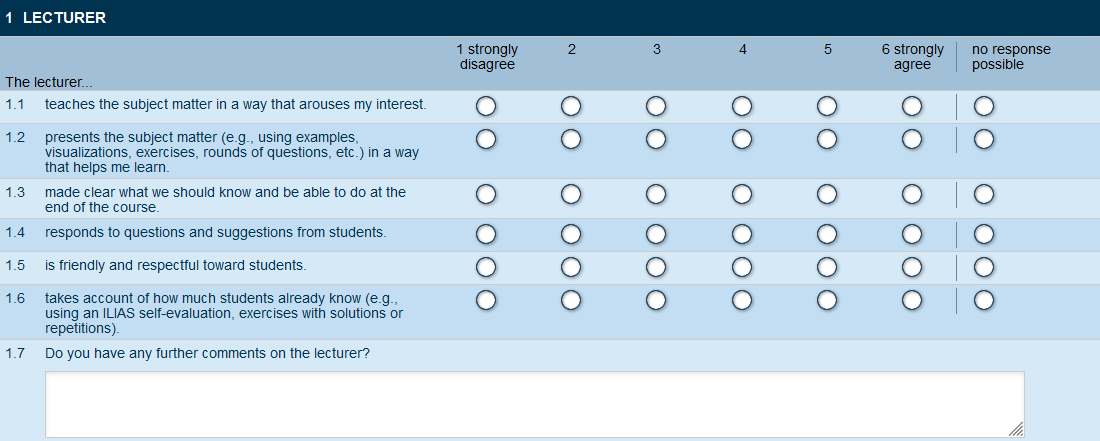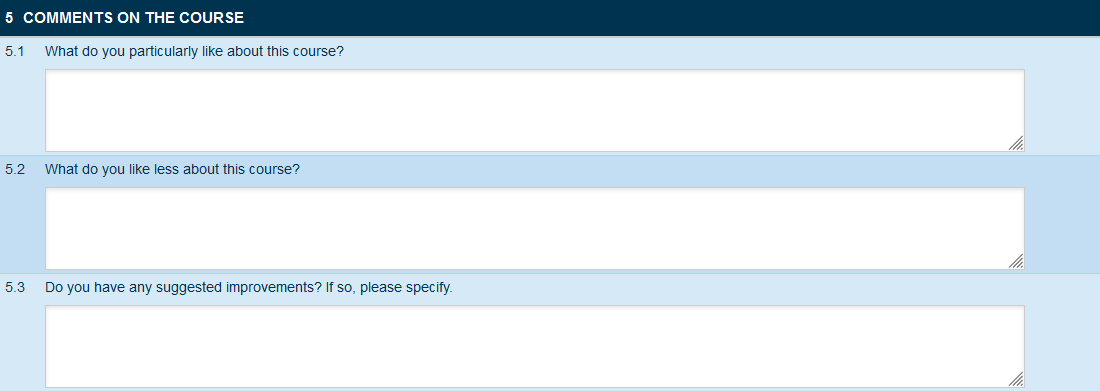Interim evaluations
The interim evaluation is a student feedback which is obtained with a standardized questionnaire. It is a service offered by the people responsible for the evaluation of courses and performance assessments at the office for QAD and is carried out in the central evaluation system evasys. The interim evaluation allows lecturers to obtain students' opinions and suggestions at an early stage of the course in order to improve the course accordingly during the semester.

Usage of the interim evaluation
VOLUNTARY
The interim evaluation is, for the most part, voluntary.
AS FOLLOW-UP
For courses that have been rated «insufficient» in a final evaluation, the interim evaluation is mandatory the next time the course is offered.

Purposes of the interim evaluation
For more information on the purposes of course evaluations click here.
1) IMPROVEMENT
The interim evaluation is strictly formative, i.e. improvement-oriented. Its purpose is to provide instructors with detailed data-based insights into the areas in which a course needs improvement (see impact model).
2) PREPARATION FOR THE FINAL EVALUATION
The interim evaluation is a useful preparation for the final evaluation. As the interim evaluation focuses precisely on the quality dimensions that constitute good teaching, it helps lecturers to identify potential for improvement. If measures are subsequently taken to optimise these dimensions, this will be reflected in the next final evaluation, as this builds on the content of the interim evaluation.
3) FOSTERING OF A FEEDBACK CULTURE
In addition, interim evaluations can promote an open feedback culture in a course.
Please note that an interim evaluation does not replace the final evaluation.

Timing of the interim evaluation
Default evaluation date: 1st half of the course dates, by the 9th week of the semester at the latest (depending on the course dates)
Method
Interim evaluations are conducted online with general non-personalized links. The link and the QR code are sent to the main lecturer or, in some cases, to an administrative unit in the faculty, who make the links / QR codes available to the students..

Content, languages
CONTENT
The questionnaire for interim evaluations is based on the Good Teaching Model and has the following structure:
- Dimension: Lecturer(s)
- Conveying the subject matter
- Defining learning outcomes
- Conduct toward students
- Learning-level related suggestions
- Dimension: Cours
- Content and structuring
- Assist learning with course material
- Level of requirement: Over- or underchallenge
- Pace
- Dimension: Students
- Active participation
- Rhythmized learning






LANGUAGES
The questionnaire is available in German, English and French.

Procedure for the interim evaluation
1. Planning
In a first step, lecturers plan 2-3 dates for the survey while preparing a course: a date for the survey to be conducted, possibly a back-up date, and a date for sharing and discussing the results with the students.
2. Registration
Registration usually takes place by the 3rd week of the semester in KSL (see registration deadlines). The evaluations must be registered via KSL.
Courses that have to undergo an obligatory interim evaluation due to an insufficient final evaluation result are usually registered automatically or by a central unit of the institute.
3. Preparing surveys
Four weeks before the middle date of the course (or immediately if registration takes place later), the registrations are transferred to the evasys evaluation system and the surveys are set up.
4. Sending the links
An email with the link and QR code for the survey will be sent to the main lecturer responsible or, if preferred, to an alternative recipient 1-3 weeks before the planned end date of the survey. This email contains the planned closing date of the survey as well as further information on the implementation.
5. Conducting the survey
The interim evaluation should be carried out in the first half of the course dates.
As soon as the person responsible receives the link/QR code, the survey can be conducted. Ideally, students should be given approx. 10 minutes at the beginning of a course session. For higher response rates, it is recommended to conduct surveys in the (possibly virtual) presence of the lecturer.
In the case of TAN surveys, the links to the surveys are sent directly to the students and do not have to be shared by a responsible person. If possible, it is also recommended to provide students with 10 minutes during a course in these cases as well.
The survey will close automatically on the date specified during registration or on a default date specified by the people responsible for the evaluation of courses and performance assessments.
6. Report
Immediately after the end of the survey, all lecturers of the evaluated course receive an automatic report, provided that the minimum response rate of 5 answers has been reached.
If fewer than 5 responses are received, lecturers are automatically informed that the report could not be generated. Depending on the response rate, the report or at least the answers to open questions can be submitted manually on request.
Lecturers can contact the people responsible for the evaluation of courses and performance assessments if they have any questions regarding the interpretation of the results.
The LEAD department is available on questions relating to higher education didactics.
7. Sharing results
It is recommended to discuss the results of the survey as well as the findings and potential consequences (e.g. improvement measures) with the students.
8. Adjustments
Student feedback can provide an opportunity to make adjustments to the course.
9. Follow up
In accordance with the good teaching model the course evaluation is designed in such a way that the questionnaires for the interim and final evaluations are harmonised in terms of content. This means that a final evaluation, which follows an interim evaluation, can provide information on the extent to which improvement measures taken have been successfully implemented in the course. It is therefore advisable to use interim and final evaluations in combination.
